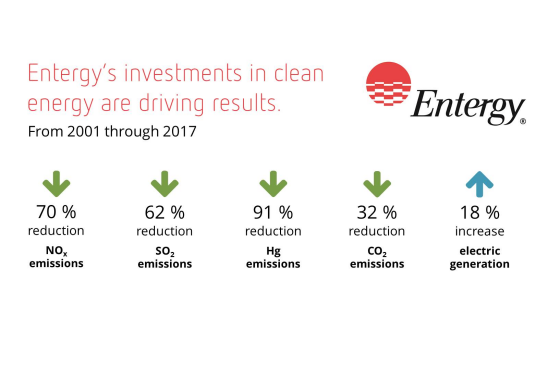Insights > New Report: Entergy Helping Lead Transition to Clean Energy, Reduced Emissions by U.S. Electric Power Sector
New Report: Entergy Helping Lead Transition to Clean Energy, Reduced Emissions by U.S. Electric Power Sector
06/19/2018
 The nation’s largest electricity producers’ transition to clean energy is reducing emissions, and Entergy Corporation is helping lead the way.
The nation’s largest electricity producers’ transition to clean energy is reducing emissions, and Entergy Corporation is helping lead the way.
In the latest comprehensive analysis of U.S. power plant emissions from the 100 largest electric power producers, Entergy is the sixth-largest producer of electricity and ranks fifth in the production of zero-emitting energy. Entergy’s CO2 emission rate is the fourth lowest among the top 20 privately-owned and investor-owned power producers.
The analysis, based on 2016 data, shows that a significant shift in market dynamics has happened, resulting in 22 percent lower CO2 emissions nationwide than a decade ago, even as the U.S. economy has steadily grown.
Entergy’s commitment to reducing emissions from its power plants is helping drive this reduction in the nation’s emissions.
“In 2001, Entergy was the first U.S. electric utility to commit voluntarily to reducing CO2 emissions,” said Chuck Barlow, Entergy’s vice president of environmental strategy and policy. “While our annual electric generation has increased by 18 percent since 2000, our investments in clean energy through 2017 have resulted over the same period in a 70 percent reduction in NOx emissions, a 62 percent reduction in SO2 emissions, a 91 percent reduction in mercury emissions and a 32 percent reduction in CO2 emissions.”
Learn more about Entergy’s portfolio transformation, energy efficiency initiatives and other actions contributing to lower emissions in our 2017 integrated report.
The nationwide data is presented in the 14th edition of Benchmarking Air Emissions of the 100 Largest Electric Power Producers in the United States, a report that Ceres, Natural Resources Defense Council and partners like Entergy have released since 1997. The report is based on publicly reported generation and emissions data from the U.S. Energy Information Administration and the Environmental Protection Agency. For the first time, the report’s power plant data has also been compiled into an interactive map and online emissions trends tool.
The 2016 data reveals that nationwide:
- From 2006 to 2016, coal’s use in electric power production has dropped from 49 percent to 30 percent.
- From 2006 to 2016 natural gas’s use in electric power production has increased from 20 to 34 percent.
- In 2016 5 percent of electric power production came from renewable sources like wind, solar and hydropower–a figure which rose to 17.1% in 2017 and is expected to continue to rise as the cost of renewables continues to decline.
Also in the report:
- Sulfur dioxide and nitrogen oxide emissions in the U.S. were 91 percent and 82 percent lower, respectively, than they were in 1990 when Congress passed major amendments to the Clean Air Act.
- Carbon dioxide emissions from U.S. power plants now measure just one percent higher than 1990 levels and fell 24 percent from 2005 through 2016.
- Mercury emissions from power plants have decreased 86 percent from 2000 levels.
“It is encouraging to see the progress that U.S. power companies are making in accelerating the transition to the clean energy economy, especially given the increased role that the sector will need to play to achieve our longer-range decarbonization goals,” said Dan Bakal, director of electric power at Ceres.

